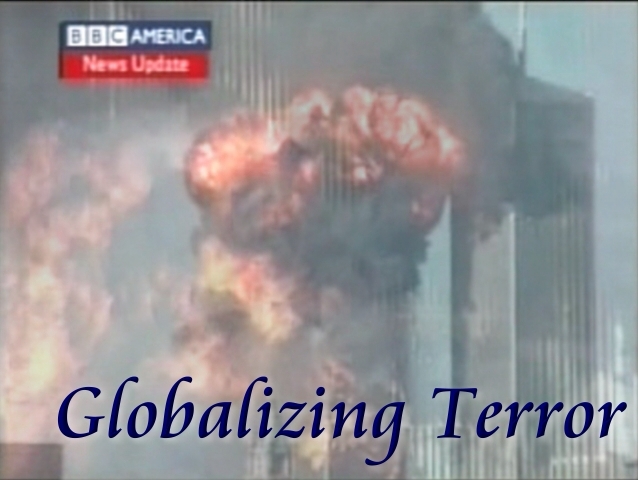
 |
In the aftermath of the attack on September 11, 2001 British Prime Minister Tony Blair said [play video]:
 |
|
Click Image to Play Video [0:04]
|
There is nothing extraordinary about his statement until you think about what he did not say. He did not say the people of New York city watched. He did not say the people of New York and New Jersey watched. He did not say Americans watched.
He was speaking to and for the world and he said we watched and felt.
The change in the speed of communication of the past fifty years has produced a revolution. For the first time in human history the shot was heard around the world.
Terror has existed through human history, but it has become a critical political issue since 9/11. The political use of terror, terrorism, is the subject of a growing library of work. Amazon lists almost 4000 books for terrorism and terrorists, including five encyclopedias of terrorism. There is also an extensive literature in scholarly journals and the popular press. Among other things, this work describes the psychological profiles of terrorists; the extent to which they are rational or irrational; the political, social, economic, and cultural environments that encourage them; public reactions to terrorism; possible and probable future terrorist scenarios; and strategies for controlling future terrorism (see Healy, et. al. 2002, for a related discussion).
The visual media have provided a feast of terrorist coverage, allowing us to move from reading about terrorism to, as the Prime Minister, said, watch it - in real time and in replay. The globalization of terror is something new. It goes hand in hand with the globalization of the media. The creation of new media technology has created a public space in which political actors may perform: Terrorists are some of the actors who can now play on a global stage. (see Norris, Just, and Kern, 2003; Greenberg and Thompson, 2002; Hachten and Scrotton, 2002; Nacos, 2002; Nelson and Boynton, 1997; Alali and Byrd, 1994; Livingston, 1994.)
We are tracing this change. We began in 1998 and have recorded between 200 and 250 news broadcasts a year. We started with CNN's WorldView. In 2001 we switched to BBC's World News. In this analysis we examine how the global news media handle terror -- the globalization of terror.
The analysis is in three parts: 1) What becomes terror in global broadcasting; 2) Terror and the synchronization of global media; and 3) How terror becomes us.
The presentation is multi-layered. Multi-layered is difficult with paper; it is easy with electronic communication. This can be characterized as the top layer. It is a surface on which we place color, text, images, and links to brief video clips. The video clips are an integral part of the presentation. Skipping the video is rather like skipping paragraphs in a text. You can skip through a text, but you miss something. In addition to the video clips there are links that lead to further development of the points made in the first and third sections. These layers include color, text, images, and links to video clips, as well. And one of the layers has a link to the data on which part of it is based. You can read as deeply in the presentation as your interest carries you.
What Terror Becomes
For a year the world watched the Kosovars living in terror. Finally, the world said enough, a brief war ensued, the terror abated -- though the hardships continued. And the world stopped watching.
The Kosovars had no monopoly on terror, of course. Today the Israelis and the Palestinians are living out mutually assured terror. The Afghans lived in terror. The East Timorese, the Eritreans, and the list goes on.
And the global media is there -- at least for a time -- making it possible for us to watch. What do they show us? What does terror become in the global media?
Kosovo is one case among many. By looking carefully at this case one can see the elements that appear over and over in the reporting. Living in terror is told as: threat and attack, fear and escape, and shock and mourning when the escape fails. [further development: Terror]
Here we will focus on the threat.
The theat is not so much what they have done to you as it is what they may do to you. It is what you dread; it is what may happen. Terror is living with what may happen.
They tried to escape the threat by hiding in the countryside. That could work in the summer, it could work if you were willing to live without housing and without food. It could work until you were found. Then they mourned.
 |
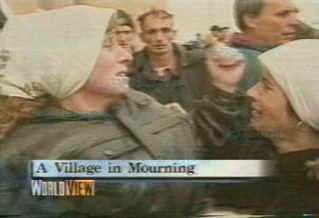 |
|
Escape; Hiding in the Countryside
|
Mourning When Escape Fails
|
As the global media tells the story, terror becomes threat, attempting to escape the threat, and mourning when escape fails.
On the Same Page
There are many similarities in news broadcasting around the world. For example, the anchor and the anchor desk are ubiguitous.
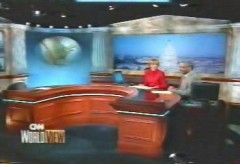 |
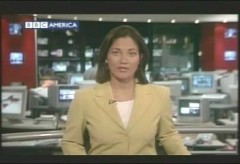 |
 |
|
WorldView
|
BBC World News
|
China
|
 |
 |
 |
|
Croatia
|
Dubai
|
Germany
|
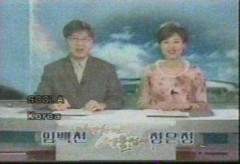 |
 |
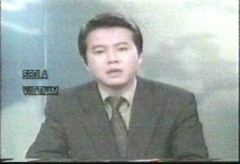 |
|
Korea
|
Russia
|
Vietnam
|
China, Croatia, Vietnam -- the anchor or anchors are managing the broadcast sitting behind a desk and in front of a map and screen display.
In addition to the other similarities there is the story of the day -- the story found in almost every media outlet. The story of the day is well known in the U.S. But there is a story of the day in news broadcasting around the world, as well. The world is synchronized in what it is shown as important.
 |
|
Click Image to Play Video [1:11]
|
The day was April 5, 2002. The Israeli invasion of Palestine was nine days old. Around the world the story of the day was the Israeli army terrorizing Palestinians and Palestinians fighting back. Terror was the centerpiece of the news from the Middle East.
There were tanks in the streets of Ramallah and Palestinian gunmen firing automatic weapons. There were helicopters attacking and destroying buildings. But the story of the day seemed to be the small arms fire as gunmen ran the length of a street. That one scene was repeated over and over in the news broadcasts we found [play video].
Forest fires in California, flooding in Europe and Bangladesh, an election in Germany -- they are all world news. But none snychronizes global broadcasting as terror does. We are all on the same page when terror is the story of the day.
How Terror Becomes Us
Tony Blair said we watched, and watched we did [play video].
 |
|
Click Image to Play Video [0:44]
|
The first twenty-five seconds a news reporter was explaining to anyone who needed explanation what we were seeing. Then we were thrust into a crowd -- shouting, screaming, shock, disbelief, terror. [Further Development: Sights and Sounds]
Terror becomes us when we see it through the eyes of the victims [play video].
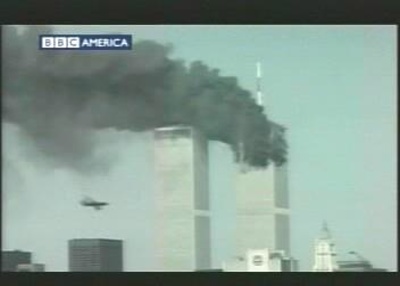 |
|
Click Image to Play Video [2:25]
|
It began with a scream and a replay of the crash into the tower and the tower burning afterwards. The images set the story. This is where the grief came from.
The voice of a victim -- a telephone message for her husband, recorded as she was waiting for death. And a wedding picture of the victim.
Then the picture of a flight attendant -- shown over the American flag. And her husband, sitting in front of a flag, recounting her call.
The camera moves back to show the large number of lives that have been destroyed. Then it moves in -- filling the screen with the face of a wife, then a father.
Pictures of searching wreckage, pictures of a victim, then the screen is filled with the face of the wife.
Finally, back to the destroyed buildings. The carnage of the lives is reinforced with images of the carnage on the ground.
We cannot miss the terror.
Terror becomes us when we are called upon to remember.
The news media remind viewers over and over about the event. It became a constant point of departure for news, and the sights and sounds were repeated and repeated.
And we were called to remember [play video].
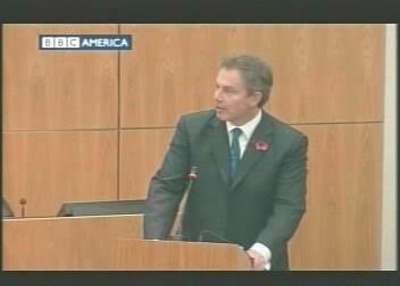 |
|
Click Image to Play Video [0:22]
|
With the assistance of global media and global politicians Osama Bin Laden brought terror to us all.
Conclusion
It begins with technology. The time required to communicate from anywhere to anywhere is now measured in seconds. Global communication has always been possible -- if you were willing to wait. But waiting only seconds brings new meaning to 'global communication' and a new human reality.
Kosovo, Israel-Palestine, the twin towers -- terror is not a sometime thing. Man's inhumanity toward his fellow men makes terror a constant in human affairs. Not very long ago most of the terror was hidden -- beyond our willingness to wait for the news. That is no longer true. We experience the terror around the world.
References
Alali, O. and G. W. Byrd (1994). Terrorism and the Media: A Selected, Annotated Bibliography. Jefferson NC: McFarland.
Greenberg, B. S. and M. T. Thompson, eds. (2002). Communication and Terrorism: Public and Media Responses to 9/11. Mount Waverly AU: Hampton Press.
Hachten, W. A. and J. Francis (2002). The World News Prism: Global Media in an Era of Terrorism. Ames IA: Iowa State University Press.
Healy, A. F., J. M. Hoffman, F. A. Beer, and L. E. Bourne, Jr. (2002) "Terrorists and Democrats: Individual Reactions to International Attacks" Political Psychology 23, 3: 439-467.
Livingston, S. (1994). The Terrorism Spectacle. Boulder CO: Westview Press.
Nacos, B.L. (2002). Mass-Mediated Terrorism: The Central Role of the Media in Terrorism and Counter-Terrorism. Lanham MD: Rowman and Littlefield.
Nelson, J. S. and G. R. Boynton (1997). Video Rhetorics. Urbana IL: University of Illinois Press.
Norris, P., M. Just, and M. Kern (2003). Framing Terrorism: Understanding Terrorist Threats and Mass Media. New York NY: Routledge.
© Francis A. Beer and G. R. Boynton, 2002.